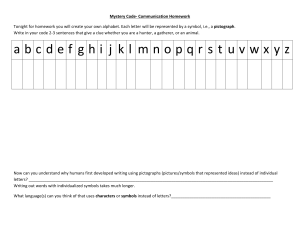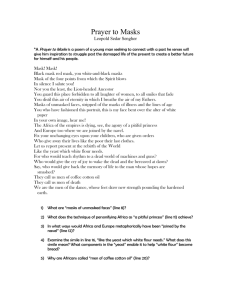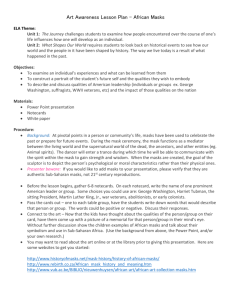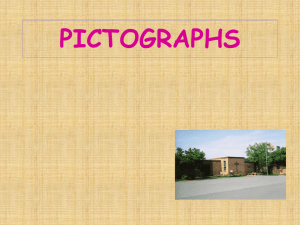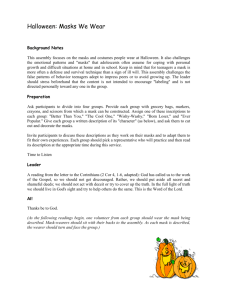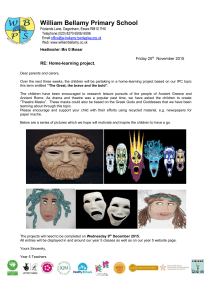native americans and the stories their artwork tell us
advertisement
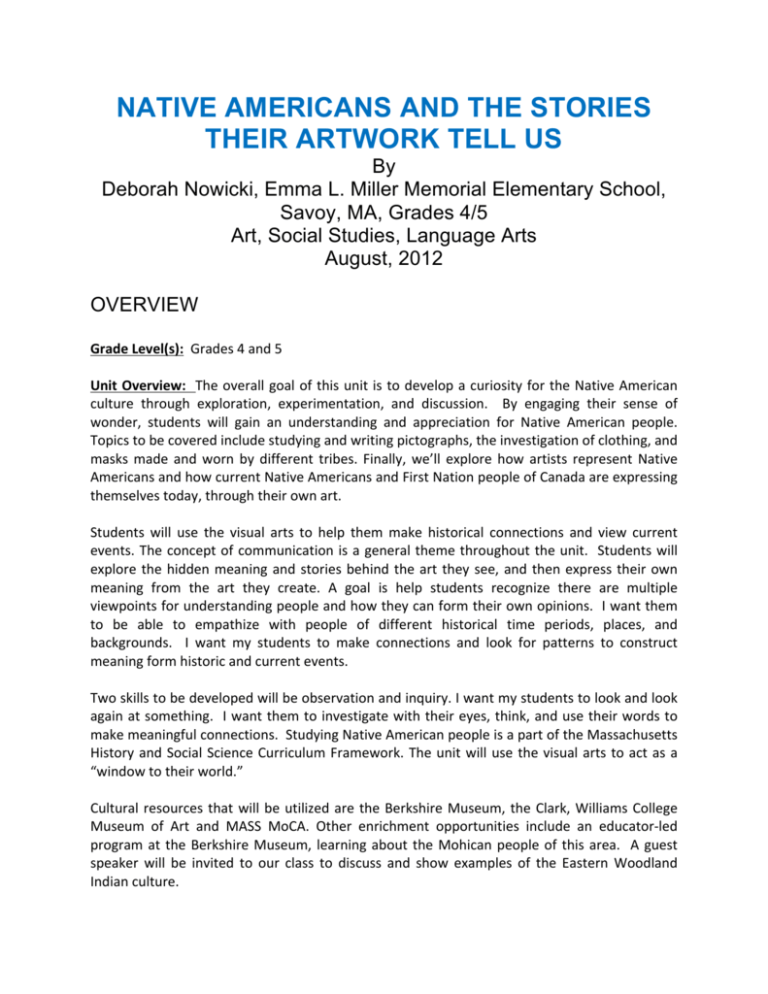
NATIVE AMERICANS AND THE STORIES THEIR ARTWORK TELL US By Deborah Nowicki, Emma L. Miller Memorial Elementary School, Savoy, MA, Grades 4/5 Art, Social Studies, Language Arts August, 2012 OVERVIEW Grade Level(s): Grades 4 and 5 Unit Overview: The overall goal of this unit is to develop a curiosity for the Native American culture through exploration, experimentation, and discussion. By engaging their sense of wonder, students will gain an understanding and appreciation for Native American people. Topics to be covered include studying and writing pictographs, the investigation of clothing, and masks made and worn by different tribes. Finally, we’ll explore how artists represent Native Americans and how current Native Americans and First Nation people of Canada are expressing themselves today, through their own art. Students will use the visual arts to help them make historical connections and view current events. The concept of communication is a general theme throughout the unit. Students will explore the hidden meaning and stories behind the art they see, and then express their own meaning from the art they create. A goal is help students recognize there are multiple viewpoints for understanding people and how they can form their own opinions. I want them to be able to empathize with people of different historical time periods, places, and backgrounds. I want my students to make connections and look for patterns to construct meaning form historic and current events. Two skills to be developed will be observation and inquiry. I want my students to look and look again at something. I want them to investigate with their eyes, think, and use their words to make meaningful connections. Studying Native American people is a part of the Massachusetts History and Social Science Curriculum Framework. The unit will use the visual arts to act as a “window to their world.” Cultural resources that will be utilized are the Berkshire Museum, the Clark, Williams College Museum of Art and MASS MoCA. Other enrichment opportunities include an educator-­‐led program at the Berkshire Museum, learning about the Mohican people of this area. A guest speaker will be invited to our class to discuss and show examples of the Eastern Woodland Indian culture. Timing: The intention of this unit is to be implemented over the course of five weeks. Lessons vary in length from 45 minutes to one hour and will occur at least once a week. Arts-­‐centric Teaching and Learning: Communication is a common thread that will be woven into each lesson. As we study Native Americans, we will use art to help us answer some questions and curiosities such as, why were masks so important to some tribes? Through research and actually making our own masks, we may find the hidden meaning to this form of communication. Native people were master craftsmen when it came to making clothes. Why did they add certain adornments, symbols and certain colors? By looking closely at different examples of clothing, and thinking about the choices that went into what was made, we may be led to discover how they lived and what they believed in. Learning about pictographs and then exploring how to create them, will help us gain a better understanding of how people who don’t speak the same language can, in fact, communicate after all. Thinking about how Native Americans lived and how their world was rapidly changing, can be explored by looking a Remington’s “The Scout,” and the photograph called “Indian/Broken Plate Glass.” What did the artists want us to know? What are current Native Americans and First Nation People trying to communicate to us with their art? By using this art-­‐centric approach, students will gain a better understanding of people from the past and present. They may even learn something about themselves! Essential Questions: • What are the different ways you can let others know your feelings, fears, likes and dislikes? • In what way does this piece of art make you wonder about anything? • What emotions or ideas do you see represented in this artwork? • What might you have in common with people who lived long ago? • What are some problems facing Native American people today? Are their problems different from ours? Overall Objectives: Students will: 1) develop an awareness of their sense of wonder and curiosity. 2) increase their observation skills/visual literacy. 3) express the meaning found in artwork. 4) show an appreciation of artwork from Native American culture. 5) communicate feelings, thoughts, and viewpoints through their words, art making, and movement. LEARNING STANDARDS Visual Arts: 1.1: Use a variety of materials and media and understand how to use them to produce different visual effects. 1.2: Create artwork in a variety of two-­‐dimensional and three-­‐dimensional media. 2.1: For color, explore and experiment with the use of color in dry and wet media 2.2: For line, explore the use of line in 2D and 3D works. 2.4: For shape and form, explore the use of shapes and forms in 2D and 3D works. 2.5: For pattern and symmetry, explore the use of patterns and symmetrical shapes in 2D and 3D works. 2.6: For space and composition, explore composition by creating artwork with a center of interest, repetition, and/or balance. 3.3: Create 2D and 3D artwork from memory or imagination to tell a story or embody an idea or fantasy. 3.5: Create symbolic artwork by substituting symbols for objects, relationships, or ideas. 3.6: Create artwork that employs the use of free form symbolic imagery that demonstrates personal invention, and/or conveys ideas and emotions. 4.6: Demonstrate the ability to articulate criteria for artistic work, describe personal style, assess and reflect on work orally and in writing, and to revise work based on criteria developed in the classroom. 5.1: In the course of making and viewing art, learn ways of discussing it, such as by making a list of all the images seen. In the artwork (visual inventory); and identifying kinds of color, line, texture, shapes, and forms in the work. 5.2: Classify artworks into general categories, such as painting, printmaking, collage, sculpture, pottery, textiles, architecture, photography, and film. 5.3: Describe similarities and differences in works, and present personal responses to the subject matter, materials, techniques, and use of design elements in artworks. Dance: 2.5: Explore movement using a variety of available objects, properties (props), fabrics, and clothing pieces, etc. 3.1: Observe, explore, and discuss how movements can show feelings, images, thoughts, colors, sounds, and textures. Theatre: 1.3: Pretend to be someone else, creating a character based on stories or through improvisation, using properties,(props), costumes, and imagery. Social Studies: 4.15: Describe the diverse nature of the American people by identifying the distinctive contributions to American culture of: at least three indigenous peoples in different areas of the country (e.g., Navajo, Seminoles, Sioux, Hawaiians, and Inuits). 5.6: Explain the early relationship of the English settlers to the indigenous peoples, or Indians, in North America, including the differing views on ownership or use of land and the conflicts between them. Language Arts: Informational Text: 4.3: Explain events, procedures, ideas, or concepts in a historical, scientific, or technical text, including what happened and why, based on specific information in the text. 4.7: Interpret information presented visually, orally, or quantitatively and explain how the information contributes to an understanding of the text in which it appears. Speaking and Listening: 4.1, 5.1: Engage effectively in a range of collaborative discussions (one-­‐on-­‐one, in groups, and teacher-­‐led) with diverse partners on grade 4/grade 5 topics and texts, building on others’ ideas and expressing their own clearly. Writing: 4.4, 5.4: Produce clear and coherent writing in which the development and organization are appropriate to task, purpose, and audience. # Lesson Description Objectives Standards Assessment 1. Native American Pictographs 1, 2, 3, 4, 5 Visual Arts: • Teacher 1.1, 1.2, 2.2, 2.4, observation Students will practice reading 2.5, 3.3, 3.6, 5.6 • Completion of a and writing pictographs. pictograph, Social Studies: following 4.15, 5.3, 5.6 teacher directions 2. A Picture is Worth A 1, 2, 3, 4, 5 Visual Arts: • Teacher Thousand Words 2.4, 2.6, 4.6, 5.1, observation 5.2, 5.3, 5.6 • Diamante poem Students will view artwork at should show the Clark, WCMA, and MASS Social Studies: understanding MoCA. Diamante poems will 4.15, 4.21, 5.3 of the subject. be written using words generated from the discussion of the artwork. 3. Communicating Through 1, 2, 3, 4, 5 Visual arts: • Teacher Clothing 2.1, 2.4, 2.5, 5.1, observation 5.2, 5.3, 5.5, 5.8 Students will go to the Berkshire Museum to observe Social Studies: variations of Native American 4.15 clothing (past and contemporary). 4. Exploring Masks of Native 1, 2, 3, 4, 5 American Culture Groups Students will research different types of masks and report to the class. Students will invent their own 3D mask and portray a character or emotion through movement. Visual Arts: • 2.1, 2.4, 2.5, 5.1, 5.2, 5.3, 5.5, 5.8 • Social Studies: • 4.15 Language Arts (Speaking & Listening): 4.1, 5.1 Teacher observation Ability to work with a partner Final art product and how much effort was put into it’s creation. RESOURCES On-­‐line Resources • Native American Pictograph Stories www.lakeshorelearning.com This is an excellent site that includes a pictograph and templates to use for the project. • Create Your Own Pictographs http://www.texasbeyondhistory.net/trans-­‐p/kids/make/design1.html This site will be helpful for teachers when beginning the lesson on Pictographs. • Pictograph Images http://www.google/imgres?num=10&hl=en&biw=1786&bil This site may be helpful for teachers and students when beginning the lesson on Pictographs. There are pictographs to copy for class use. • Parent and Afterschool Resources: Grades 3 – 12: Diamante Poems http://www.readwritethink.org/resources/resource-­‐print.html?id=30185 This site is a great resource for teachers to learn how to teach the writing of these types of poems. It will be useful for the lesson A Picture Is Worth A Thousand Words. • Diamante Poem Template http://writingfix.com This site will be useful in the lesson A Picture Is Worth A Thousand Words. Teachers can copy the template to have students write their poetry. • Native American masks https://www.google.com/images This site will be helpful for the Exploring Masks lesson. Teachers and students can get examples of what many Native American masks looked like. • Incredible Art Department: Paper Masks http://www.princetonol.com/groups/iad/lessons/elem/papermask.htm This site will be helpful for the Exploring Masks lesson. It is a useful site for teachers as it explains the basics of mask making. • Dance of the Kwakiutl http://www.youtube.com/watch?v=FYXQG65JvL8 This site will be helpful for the Exploring Masks lesson. It will give teachers and students an example of how masks were incorporated in dance. There is music to listen to as well. Cultural Resources Berkshire Museum: Lessons: Communicating Through Clothing, Exploring Masks of Native American Culture Groups, Educator-­‐led lesson on the local Mohican tribe and culture The Clark: Lesson: A Picture is Worth A Thousand Words MASS MoCA: Lesson: A Picture is Worth A Thousand Words WCMA: Lesson: A Picture is Worth A Thousand Words Dan Shears Eastern Woodland Culture Available for school groups -­‐ 413-­‐743-­‐8938 LESSON 1: Native American Pictographs Grade Level(s): Grades 4 and 5 Lesson Overview: Native American people expressed themselves through their art in many ways. This lesson will explore the idea of pictographs being another art form that has the dual purpose of communicating to others. Time Frame: This lesson will take two class sessions of about 45 minutes, and a third session of about 60 minutes. The first session will be devoted to learning what pictographs are and looking as samples from different Native American tribes. The class will try to decipher a few of them by working together and possibly moving on to deciphering with a partner. Time to share should be given. Preparing the materials needed to create the pictographs will be done in the second session. During the third session, students will make their own pictographs by either using samples of designs from one or two pictograph story keys, or they may design their own story key. Students will share their artistic stories with the class. Essential Question(s): • How do you communicate with your friends and family? • How would you get your point across to someone if you didn’t know their language or there? • What if the alphabet hadn’t been invented and you needed to write a message. How would you communicate your message? Objectives: Students will: • explain why Native Americans created and told stories with pictures. • understand what pictographs are and read a sentence using them. • make a brush out of found material to write their pictograph with. • use their imagination and creativity to write a sentence or paragraph of their own, using pictographs from a chart or their own invented pictographs. Standards: Visual Arts: 1.1, 1.2, 2.2, 2.4, 2.5, 3.3, 3.6 Social Studies: 4.15, 5.3, 5.6 Language Arts: Informational Text: 4.3 Writing: 4.3, Speaking and Listening: 4.1, 5.1 Materials: o examples of pictographs o chart paper, markers o paper, pencils o sticks, pine tree needles, straw, hay, other natural materials to make fiber brushes o scissors, tape o roll of brown post office mailing paper o red, yellow, brown, black tempera paint o paint brushes (optional) Procedure: 1. Ask the essential questions from the Overview to peak curiosity. 2. Explain that Native Americans often communicated and told stories using pictures of objects called “pictographs.” Explain that there was no formal alphabet to write words, so they got their ideas across in different ways. Ask if they think they can figure out what some of their stories say. 3. Show one of the pictograph examples. Point out some of the symbols and have a brainstorming session as to what the symbols represent. Write what the students think the symbols stand for. Then have them tell the story. There could be many different versions! This warm-­‐up activity could be done with as many pictographs as you wish. 4. Show one of the pictograph keys with the words underneath each symbol. (There is a sample at the end of this lesson). Write a sentence or two with the whole class, writing only the symbols on chart paper. Then have someone read what it says. This can be repeated a few times, or let the students work in partners to make up their own stories. Save time for sharing. 5. On the second day, present the natural materials and tell the students that their mission is to invent a brush that they will use in a future class to draw their symbols with. Have some paint available so they can test their brushes and make any adjustments needed. They will also draw the outline of an animal skin on the brown post office paper and cut it out. If they have time, they can begin a rough draft of a story on scrap paper, using pencils to sketch the symbols. 6. On the third day, the students will take time some quiet time to develop and write a rough draft of a meaningful story using the pictograph dictionaries, or an invented dictionary to tell a modern story about themselves. 7. Students will then begin their final product on their cut out animal skin shapes. They should draw the symbols in pencil before painting. 8. When they are dry, students may wish to crumple up the brown paper to give it a more realistic look of an animal hide. 9. Students can exchange their pictographs and “read” each other’s stories. They may also enjoy sharing what they learned with students from other classes. 10. As an extension, students could write their pictograph stories, in English, on another piece of paper and display side by side on a bulletin board. Assessment: • Students will be assessed by teacher observation during the class discussion and activities. • Was the student able to interpret meaning from at least 2 or 3 of the symbols? • Did the student demonstrate knowledge of the methods used to tell a story, with symbols, by using the materials correctly? • Was the student able to create at least a one-­‐sentence story using the pictograph dictionary or an invented dictionary of symbols? • Was the student able to explain why this form of art was important to the Native American population? How would you get your point across to someone if you didn’t know his or her language? Resources: www.lakeshorelearning.com http://www.texasbeyondhistory.net/trans-­‐p/kids/make/design1.html http://www.google/imgres?num=10&hl=en&biw=1786&bil LESSON 2: A Picture Is Worth A Thousand Words Grade Level(s): Grades 4 and 5 Lesson Overview: Students will view The Scout by Frederic Remington, at the Clark and Indian/ Broken Plate Glass by Carrie Mae Weems (from the Hampton Project), located at WCMA. Students will focus on Ruth Cuthand’s Surviving West Nile and her other three pieces of beaded renditions of germs and Terrance Houle’s vinyl Buffalo piece; both artists are part of the “Oh Canada” exhibit at MASS MoCA. These works of art, by the First Nation people, the Canadian equivalent to our Native Americans, will serve to develop curiosity and visual literacy through questioning and conversation. Students will write Diamante Poems using words generated from the works of art. The works of art will lead to an examination of past and current issues important to Native Americans, and others, as well. Such topics to be explored will include the effects of western expansion, the spread of European diseases, environmental issues, and any other topics the students are curious about. This lesson fits into the unit as it uses works of art to help students become critical thinkers about the past and present. Time Frame: This lesson can be done in 3 separate sessions of 40-­‐45 minute lessons, or in one day, visiting each museum. A teacher may also opt to use only one museum and focus on the art piece or pieces there. A 30-­‐40 minute session, using the essential questions as a springboard to peak curiosity, should be completed before the visit(s). The Diamante poems can be generated on the spot orally or written, or completed as an extension lesson later on. If students are not familiar with this poem structure, a lesson will be needed beforehand. Essential Question(s): • What do people mean when they say “A picture is worth a thousand words?” • How can a painting or other piece of art “talk to you” or tell you a story? Objectives: Students will: • learn how to look at a work of art for clues to its message. • tell a story using a painting or other piece of artwork. • write a Diamante poem about one piece of art and share it with their classmates. • explain at least one significant historical event that led to the shrinking of the Native American population. Standards: Visual Arts: 2.4, 2.6, 4.6, 5.1, 5.2, 5.3 Social Studies: 4.15, 5.6 Language Arts: Informational Text: 4.7, 5.7 Speaking and Listening: 4.1, 4.4, 5.1, 5.4 Writing: 4.4, 5.4 Materials: o chart paper, pencils, paper, clip boards, o one or two examples of paintings or other works of art o examples of Diamante poetry o Diamante poem template Procedure: 1. Before the field trip(s), ask the essential questions to start a dialogue. Record students’ responses on chart paper. 2. Show one or two paintings or other works of art to practice. Use the questions in the Overview section. Continue to record responses on chart paper. 3. As a class, orally generate a story about one of the chosen pieces of art. Asking “how” and the “who, what, when, where, why” questions will be helpful. Guidelines about appropriate topics will need to be discussed beforehand. 4. At the museums, ask students not to read any information about the art until after the lesson. Begin the discussion by taking a visual inventory of the piece. Shape, line, color, space, and texture can be explored. Encourage students to look closely. 5. Use the format in Step 3 to begin a conversation about what they think is “going on.” Create a story about the painting, etc. Create another story using other students’ ideas as well. The point is to get the students’ creative juices flowing. 6. Using the format for Diamante poetry, ask students to come up with a topic, adjectives, “-­‐ing” words, and nouns to create a poem that reflects what the painting, photograph, etc. means to them. 7. Ask students if they think art can serve more than one purpose. Lead a discussion about the messages the artists might be trying to communicate to us. Assessment: Students will be assessed using the following questions: Did the student show interest and take part in the pre-­‐visit activities in Steps 1, 2, and 3? • Was the student able to make one or two observations about the works of art? • Did the student become involved with the story process, using the art work as a prompt? • Using the format for a Diamante poem, was the student able to write a poem that shows understanding of the work of art? Resources: • Directions for Diamante poetry can be found at http://www.readwritethink.org/resources/resource-­‐print.html?id=30185 • A template for Diamante poetry can be found at: http://writingfix.com • Trail of Tears 1830 – 1858: www.thenagain.info/webohron/USA/TrailofTears.htm • Native American Diseases http://www.dummies.com/how-­‐to/content/diseases-­‐ decimate-­‐native-­‐american-­‐populations.html • LESSON 3: Communicating Through Clothing Grade Level(s): Grades 4 and 5 Lesson Overview: From an art-­‐centric viewpoint, students will study past and present clothing items made by Native Americans from different parts of the United States. The question of whether or not what they are looking at is art, or simply examples of clothing will be explored. What messages, if any, lie within the skins and fabrics? What do the materials tell us about the person who wore it? Studying the many items in the “Rethink! American Indian Art” exhibit at the Berkshire Museum, in Pittsfield, MA, students will gain a new perspective on what art might look like and what we can learn from it. This lesson fits into the broader context of the unit as it focuses on the possibility of clothing being a work of art that can also reveal information about the Native American culture. Time Frame: One 45-­‐minute lesson prior to the museum visit and one 60-­‐minute lesson at the Berkshire Museum Essential Question(s): • Do people choose the clothes they wear for warmth and comfort only? • Can you tell anything about a person by the clothes he or she wears? Objectives: Students will: • examine the various types of Native American clothing on exhibit. • make comparisons between past and present day Native American clothing. • decide whether clothing is made purely for practical purposes or for other reasons as well. • interpret how the clothing items might reflect events, ideas, and customs of Native American people. Standards: Visual Arts: 2.1, 2.4, 2.5, 5.1, 5.2, 5.3 Social Studies: 4.15 Language Arts: Speaking and Listening: 4.1, 5.1 Materials: o paper and pencils (if students wish to take notes) Procedure: 1. Before the day of the field trip, have the following quotes written on the board or chart paper: “A wolf in sheep’s clothing” “What strange power there is in clothing.” (Isaac Bashevis Singer) “One should either be a work of art or wear a work of art.” (Oscar Wilde) “Adornment is never anything except a reflection of the heart.” (Coco Chanel) “What I really love about clothes is the fact that they contain someone’s personal history – I find myself wondering about their lives.” (Isabel Wolf) Reveal one quote at a time and ask the students what they think it means. Record their responses. Expressing your own curiosity, generate a class discussion. Ask if these quotes and fellow comments have left them with more questions than answers. Reveal the essential questions that you have previously written on chart paper. Continue the class discussion while recording responses. 2. Tell the class that they will be taking a field trip to the Berkshire Museum to try to find the answers to the questions and to make more meaning out of the quotes. 3. While at the museum, tune into, and build upon the students’ visual literacy skills. Questions pertaining to color, line, texture, materials used, shapes, pictorial representations, symbols, etc. 4. Further questions to ask: o Who do you think owned this item? o How old was the person? Why do you think so? o Where do you think he or she lived? What makes you say that? o How do you think the clothing made the person feel (sad, powerful, joyful)? Why? o What do you think the person does? Was he rich or poor, weak or strong? o Where do you think these moccasins took this person? o Try to imagine the person’s face underneath this headdress (or hat.) What do you think the person looked like? o Does this piece of clothing remind you of anything? o How clothes tell a story like a book or a painting? o What message do you think the person who made this piece is trying to tell someone? o Do you choose the clothes you wear for warmth and comfort or for other reasons? o What is a fashion designer? o Is clothing art? Why or why not? Assessment: • Students will be assessed by teacher observation during the pre-­‐visit lesson and the actual lesson conducted at the museum. • Is the student engaged? • Does the student participate in the discussion? • Does the student make any connections to the art seen at the other museums he has been to? Resources: “Rethink! American Indian Art” exhibit at the Berkshire Museum, in Pittsfield, MA LESSON 4: Exploring Masks of Native American Cultural Groups Grade Level(s): Grades 4 and 5 Lesson Overview: Students will use their skills of observation and exploration to discover masks of Native American culture groups. This lesson will help students understand that masks were used as a form of communication. The students will then show understanding by constructing their own masks and demonstrating, through movement and discussion, what message or messages their masks convey to others. This lesson fits into the overall unit as it explores Native Americans from the art-­‐centric perspective of masks and how they are used as a form of communication. Time Frame: Three 60-­‐minute lessons Essential Question(s): Why did/do Native Americans make masks? Objectives: Students will: • describe the importance of masks to the Native American culture. • create a three dimensional mask using their imagination and rational thinking. • wear their created mask and use movement to convey a message to others • explain/discuss the elements of their mask and its purpose. Standards: Dance: 2.5, 3.1 Theatre: 1.3 Visual Arts: 1.1, 1.2, 2.1, 2.4, 2.5, 3.3 Social Studies: 4.15 Language Arts: Informational Text: 4.7 Speaking and Listening: 4.1, 5.1 Materials: o masks (on display at Berkshire Museum) and examples of masks (internet) o paper plates of different shapes and sizes, construction paper o markers, pencils, paint, brushes, yarn, beads, feathers, shells, etc. o noisemaker materials, such as pebbles, corn, beads o scissors, glue, masking tape o Native American music, chart paper Procedure: 1. The teacher will use the essential questions listed in the Overview section to peak curiosity and visual literacy through inquiry. 2. Students will work with a partner to research different types of masks used by different culture groups: Northeast, Southeast, Plains, Northwest, and Southwest. 3. Student pairs will report information gathered in their research to help build a classroom chart: Tribe name, mask name, reason used, materials used. 4. Students will conceptualize a mask they will make to convey a message to others. They will make a sketch of their intended mask and list the materials they will need to construct their mask. 5. Students will create a mask and then portray, using music and movement, what the intention of the mask is. 6. Through discussion, students will share what they learned about the importance of masks, as a form of communication, in Native American culture. They will also share their feelings about the lesson. Assessment: Students will be assessed using the following questions: • Did the student show understanding, through discussion, of the usage and importance of Native American masks? • Was the student able to effectively gather information to add to the class chart? • Did the student construct a three dimensional mask, and show, through his words and actions, his ability to communicate a message to others? Resources: You can find examples of Native American masks at: o https://www.google.com/imghp?hl=en&tab=wi o www.snowwowl.com/naartmasks.html You can find instruction and ideas for making masks at: o http://www.princetonol.com/groups/iad/lessons/elem/papermask.htm You can find music and examples of Native American dancing on: o http://www.youtube.com/watch?v=FYXQG65JvL8

